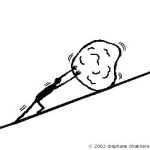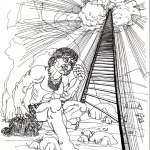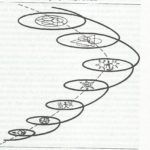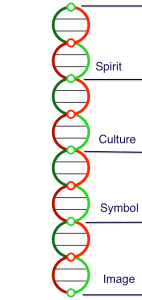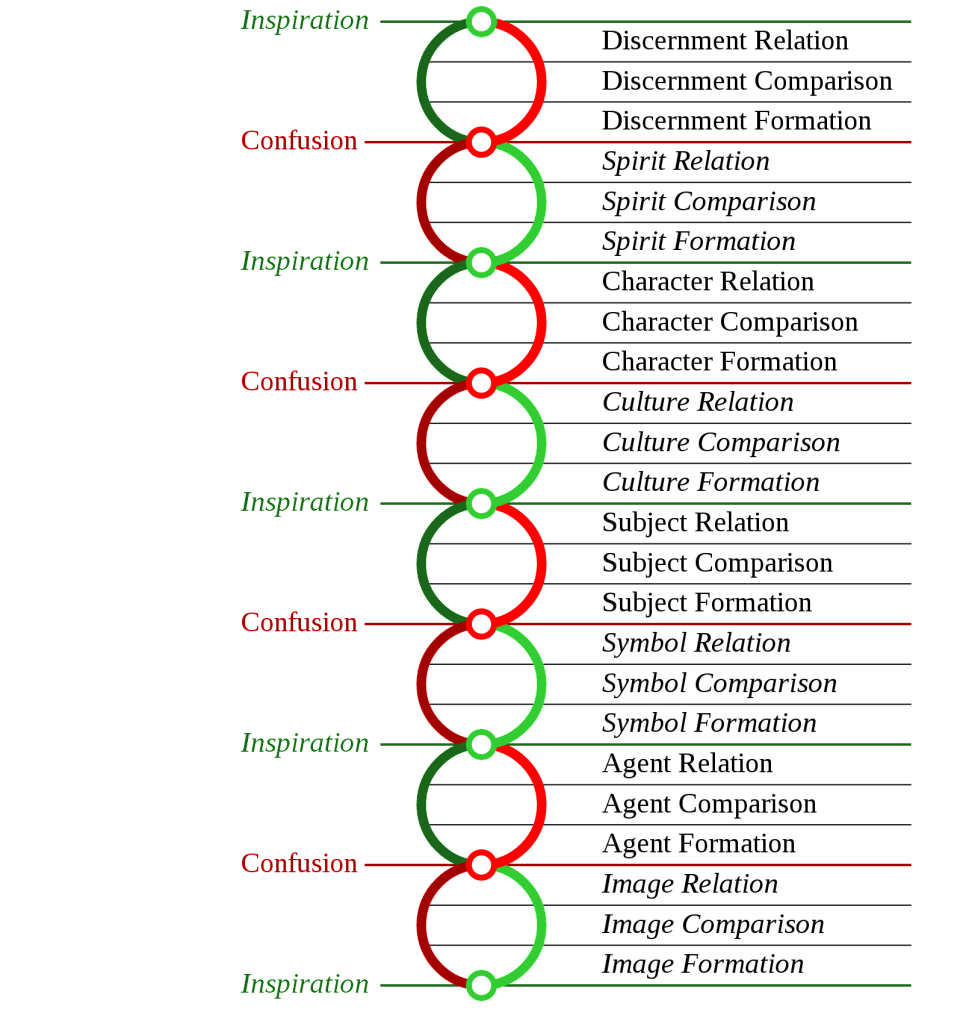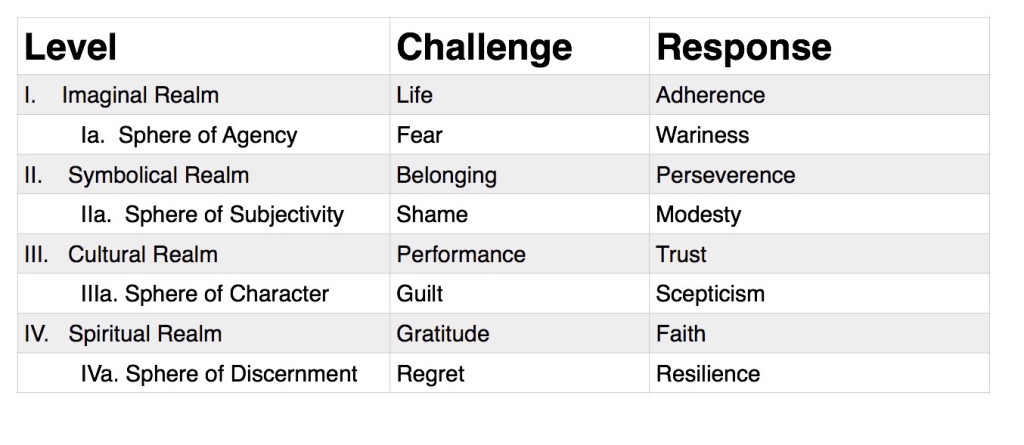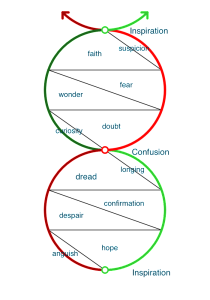(bottom)
Links on this website are underlined blue, such as in the following two lines:
This website is dedicated to Bhuwan Lal Joshi (1930 to 1977), Donald Nicholl (1946 to 1997) and M. Brewster Smith (1919 to 2012).
For an account of how I came across this model, see My Projects//Double-Helix Dynamics: How It Came to Be.
This over-view section begins by setting the double-helix pattern in its historical and cultural context. Next, the basic features of the model are detailed, followed by a synopsis of the developments explicated by the model. Finally, I answer the question: “What drives the model?” [hint, it’s not NASCAR]
Models of Development
Humans have used various models to define patterns of change. Patterns can be described, but the nature of a model implies something of the nature of what is being modeled.
The most ancient model of change is circular, based on the cyclical nature of the seasons: Spring, Summer, Winter, Autumn (such as the “four ages of man” in Hindu philosophy, Greek mythology and English poetry). A circular model implies that although relationships change during the course of the cycle, they return to their former state at the “end” (or “beginning”) of the cycle. Thus deciduous trees grow new leaves each Spring and shed those leaves in the Autumn; next Spring they again sprout new leaves.
Of course the cyclical model doesn’t account for the linear growth of the tree over the years as it gets taller and wider with deeper roots. The linear model of change is most associated with Western/historical thinking which implies steady progress as the norm. This works as long as the tree is growing, but not when it is in decline. That’s when the cyclical model can come back with the perspective that the growth of the tree is part of a larger cyclical pattern of life and death: the old tree producing a young tree before it dies, and the young tree becoming an old tree.
To which the linear model can reply that the young tree is not the same tree as the old tree even if it too becomes old, but that over time trees evolve to be better adapted to their environment, making the new tree not the same tree reincarnated, but a different tree in a linear evolutionary adaptation. Which leads to the circular retort that the evidence is a lot more messy than the linear model would imply and that samples of slow steady progress may be more the exception than the rule.
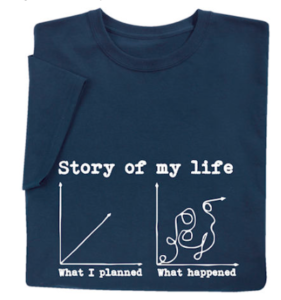
“Hey, I started and ended the same places that I planned, only the trip in-between was much more interesting than I imagined it would be!”
The outcome of this debate can literally put the linear model in a twist, resulting in the spiral model. The main advantage of the spiral model is that it can accommodate the uneven and unpredictable qualities of change while establishing a broader view of developmental progress. The shape of the spiral also makes it easier to imagine how we revisit questions in life from a different vantage point. For instance, the question “who is my friend?” is answered by young children as “who I play with,” by school age children as “who I share interests with,” and by adolescents as “who I share the principles of mutual trust and loyalty.”
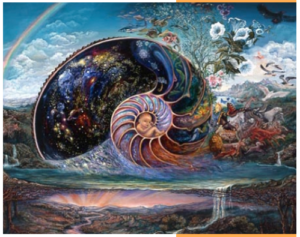
Dr. Cook-Greuter likes the nautilus design to depict development. The nautilus is an “embodied” spiral. For more, see my conversation with Dr. Cook here.
The weakness of the spiral model is that as a single strand, it lacks orientation and can spin off in any direction (or even spiral down). Arguments can be made against it spinning off in any direction, but those arguments do not come from the spiral model itself.
By defining a second strand and its relationship with the first, the double-helix model provides that orientation. Although it may appear as though the second strand is putting the first strand in a “straight-jacket,” in reality the second strand’s relationship to the first strand can deepen and enrich our appreciation of the first strand itself. Therefore, keeping both strands in view provides similar “depth perception” as our two eyes revealing the three dimensional space versus the two dimensional world of a single eye’s vision.
Explicit and Implicit
The reason that it is harder to detect the double-helix than the spiral is that at any given time one of the strands of the double-helix is implicit, and therefore “hidden” from consciousness. The relationship between explicit and implicit has many equivalents such as conscious/sub-conscious and known/unknown. Perceptually we differentiate foreground and background, or focus and context. [For more on this, see my article You Are Two and We Are One linked here.]
In National Geographics Your Brain: A User’s Guide (2015), a visual metaphor is used to describe the relationship between consciousness and subconsciousness: “In a typical day, every person goes through two obvious states, waking and sleeping, but each of these has sublevels of awareness based upon controlled and automatic mental processes. In a conscious state, the brain turns its attention to one thing after another, like a spotlight swinging through a dark night. The unconscious mind brings in information at the edge of the light, and sometimes even in the darkness.” (pg. 78) [The “spotlight” metaphor is from William James; I prefer the “chopstick” metaphor of stereo vision that Lawrence Weschler uses to depict how we “pick out” a focus (“Double Vision” in Uncanny Valley, 2011).]
Some theorists believe that we can never really know anything because the act of knowing itself changes the thing known. But that only begs the question: how can we know anything except by changing it? We change water by splashing it, drinking it, freezing it to make ice or boiling it to make steam. As a result of these ways of changing water, we know more about water. Specifically, by changing water in these ways, we get to know different aspects of water (that it is splashable, drinkable, freezable, boilable).
A general conclusion from this discussion is that different ways of knowing reveal different aspects of reality. The question then is what are these different ways of knowing and how do they emerge in development?
A general conclusion from this discussion is that different ways of knowing reveal different aspects of reality. The question then is what are these different ways of knowing and how do they emerge in development?
The model, as depicted, show a “side view” (or profile) with consciousness on the right and sub-consciousness on the left. For a depiction of the model from the “front view”, click here.
Affirmation and Negation
The double-helix model will outline four ways of knowing reality, identified as realms of awareness. The term “realm” is meant to capture the all-encompassing quality of the experience: we operate within a realm like a fish swims in water. By contrast, a domain or sphere can be pictured as discretely separate.
But implicit to every way of knowing are the limitations of that way of knowing. So first there is an affirmation of a new way of knowing, and then the negation of the omniscience of that way of knowing. Here is where we get into the real dynamics of the double-helix: affirmation and negation are the thesis and antithesis, the ying and yang of the model. At first affirmation is explicit with the person having a new way of understanding the world. Negation is implicit at first as the person explores this new understanding, inevitably coming across the limitations of the new understanding. Then negation becomes explicit while a new affirmation becomes implicit.
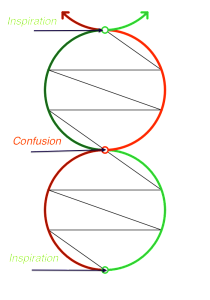
Inspiration brings affirmation and savoring skills to consciousness, and then Confusion brings negation and coping skills to consciousness.
Affirmation and negation are associated with distinctly different experiences and realizations. Affirmation is experienced as expansion and opportunity; negation is experienced as restriction and limitation. Affirmation is associated with levity and negation is associated with gravity. Affirmation is in the fore-ground of consciousness; negation is in the fore-ground of self-consciousness. In this model, consciousness is initiated by inspiration; self-consciousness is initiated by confusion. We are drawn into the world by inspiration; we are thrown back on ourselves by confusion. Inspiration and confusion are realizations that occur to us and are the key cognitive emotions of the double-helix model. A realization is more than a cognition and more than an emotion — it is uniquely grounded in reality. [For more on “cognitive emotions,” see section at end of this page.]
The descriptions of the interactions between “explicit and implicit” and “affirmation and negation” show the differences between the double-helix and spiral models. Robert Kegan’s model of subject-object dynamics (repeated in his major works) picks up the figure/ground shift as the “subject” (ground) itself becomes “object” (figure) in self-consciousness. But his spiral formation leaves out the subconscious (implicit) accompaniment that interacts with consciousnessand self-consciousness in an on-going way.
Formation, Comparison and Relation
The double-helix model defines four realms of consciousness and four corresponding spheres of self-consciousness. This gives us eight domains to cover.
The powers of understanding in each way of knowing are themselves developed as they are explored within the domain. In this way, each domain has an inherent structure. The inherent structure has common features as follows: first, a new idea is formed (formation); next, the idea is compared with other ideas (comparison); finally, the ideas are related in a coherent way according to the powers of the way of knowing. This structure applies to both knowing the world and knowing the self. For some analogies of how formation/comparison/relation work, click here.

Formation, comparison and relation in the Symbolical Realm, showing the advent of language (symbol formation) and its internalization (subject formation).
Here is an example of this from the period of development of young children from the time they start to acquire language to when they internalize language (approx. 18 months to 3 years). One word speech is the formation of a symbolic idea; two-word sentences help clarify one symbolic idea from another; declarative sentences cover the noun-verb-object relations of simple syntax.
With three steps for each of eight domains, the double-helix model comprises a total of 24 steps. There are two ways in which not everyone experiences these steps: 1) a person doesn’t attain a higher level of understanding (this will be clarified further in the debate over “formal” versus “post-formal” operations), and 2) a person is particularly intuitive within a domain and effectively skims right over the steps to the next level of understanding. In the second instance, we can say that the steps are still there but that this person doesn’t need to linger on them, but understands the domain more holistically.
Imaginal, Symbolical, Cultural and Spiritual Realms
A brief description of the four realms and their accompanying spheres of self-consciousness will be presented here. These realms are embedded rather than separate ways of knowing and therefore continue to add to our experience after we have entered a new realm (albeit more tacitly).
Imaginal: Infants first know the world through the images formed by their senses. As more of the world becomes familiar and they bond with their care-giver, infants come to realize unfamiliar things as “strange.” With the advent of “stranger anxiety” (approximately 9 months of age), infants use their growing physical abilities to seek out the familiar and avoid the unfamiliar. They prefer to explore the unfamiliar from the secure base of their bond with their care-giver. Self-consciousness in this realm focuses on the self as agent of actions that have immediate results.
Symbolical: Infants in the imaginal realm learn how to imitate the words used by those around them before they understand the symbolical power of words. Once children understand the symbolical nature of words, they enter a whole new realm with new powers. Words help children get what they want and need immensely which helps explain the happy tyranny often referred to as the “terrible twos.” The fact that most children get weaned from this between three and four years old without significant trauma is a testament to the patience and persistence of most parents. As a result, children shift from using language to control others to internalizing language to control themselves. As a result, children learn modesty, manners, subjective verbs and counter-factual sentences. Self-consciousness in this realm focuses on the self as subject whose subjectivity is different from the subjectivity of others: Junior wants Mommy to clean up after him, but Mommy wants Junior to clean up after himself.
Cultural: Children and youth in the cultural realm are learning how to be contributing members of society. Around age seven children start to apply the self-control they have learned and engage in culturally relevant and expected performances. In the “concrete operations” phase (seven to twelve years old) children become increasingly agile at performing increasingly complex routines of various types (anything from multiplication tables to gymnastic routines). Their focus is on gaining the approval and admiration of others (“Look at me! Look what I can do!”). Children who are competent and successful at these tasks tend to have narcissistically high self-esteem. Puberty is usually sufficient to derail that, but not always. The abstract abilities of “formal operations” and its associated self-consciousness shifts the focus from “how good are you at doing that?” to “how good is it to do that?” Actions become evaluated by principles and not living up to principles engenders a sense of guilt. On top of this, principles sometimes contradict each other. All of this contributes to the notoriously low self-esteem of many adolescents. Self-consciousness in this realm focuses on the self as character that is stronger or weaker than others.
Spiritual: Adults in the spiritual realm are shifting from “either/or” formal logic to “both/and” systemic logic. This is generally in line with “post-formal” researches which tend to be overly complex and jargon-laden. Remember, this is a development born of inspiration: we belong to the universe and therefore are inter-dependent. If this doesn’t put a smile on your face we are not talking about the same thing. The adult realizes this as a mature attitude that cannot be maintained naively and must be ready to cope flexibly with what life dishes up. Ultimately, no matter how well life treats a person, the limit on this spiritual way of knowing reality is death itself. And for those that life treats harshly, the ability to maintain a life-affirming stance in the face of evil is a form of spiritual self-preservation. Self-consciousness in this realm focuses on the self as steward of creation, both creature and co-creator.
Developmental Challenges and Adaptive Responses
Outlined below are the developmental challenges presented at each level of development and the adaptive responses that lead to continued social and emotional growth. It has similarities to Erik Erikson’s model, but differs in various ways (such as having two stages in infancy — image and agent — whereas Erikson one — basic trust vs. mistrust).
Imaginal Realm: Initially the challenge for the infant is life itself — for the infant to thrive it must adhere to life. If the infant’s body or environment are too unhealthy, it can fail to thrive (even with a lack of caregiver bonding, first described by James Bowlby as “hospitalism”).
Next the infant uses the caregiver attachment as a base to explore the unfamiliar and possibly unsafe world. In order to do this the infant needs to be able to “go to” the unfamiliar and “get back” to the caregiver as an agent. The infant now can begin to regulate the fight or flight instinct and face fear with wariness as a way to learn about the unfamiliar.
Symbolical Realm: Language brings the child into the social world of family and visitors where the child has a “place” to belong. It is important for the child to persevere in learning language and other skills to thrive in the newly symbolic world. Parents should “bathe” their child in language to boost her learning and ability to belong.
Next the child learns that his impulsiveness and the expectations of self-regulation (clothing, toilet-training) create challenges to belonging that generate shame. Through the internalization of language, the child learns how to “stop and think” in order not to be rude or an embarrassment. These self-control skills are crucial to life-long social success.
Cultural Realm: School age children who have sufficient self-control skills can shift their attention to fulfilling the roles they take or are given. These roles require that the child promise to learn how to be competent at the tasks involved and promise to perform those tasks when required by the role (e.g. a student does his homework). Children are “enculturated” into these roles and learn them by trusting a mentor. These performances are “concrete operations,” and have no way of evaluating the performance outside the standards of the performance itself. Other ways of doing things are generally considered the “wrong way.”
Next the adolescent discovers that a perfectly competent performance can be wrong because it is evaluated in a different context. For instance, someone who is good at tricks on the bicycle and who might be applauded for winning a competition is likely to get a different response doing the same tricks on a crowded side-walk. He may be sure of his skills to avoid hitting anyone, but others are likely to be startled and could have an accident because of the unexpected distraction. Without a sense of guilt and skepticism of one’s own motives and developing character, “performance artists” tend to become narcissistic. The abstract skills of “formal operations” allows youth to evaluate their assumptions and beliefs as theories and conceptions rather than as final and absolute truths. In a similar way, trust in individual mentors can be challenged or broken by disappointments or betrayals.
Spiritual Realm: Adults who have established a stable identity and a trustworthy character are often burdened by the demands of their own conscience and inflexible problem-solving styles. This is where the “intuition of being” and gratitude become life-savers because when you don’t take anything for granted, everything becomes a gift to be grateful for. This allows one to have faith in humanity even when trust in an individual has been lost. It also allows one to entertain, or be entertained by, multiple perspectives which can then help with more imaginative and flexible problem-solving styles, and more harmonious relations. One learns how to be more giving without being taken advantage of.
In the end, we ultimately come up against the final limit, death, no matter how spiritual we have become. At the same time many experience the living death of oppression, imprisonment and torture. In these circumstances, a strong-hearted spirituality helps provide the discernment to maintain a sense of humor, perceive who is a friend and who is an enemy, and project forgiveness as a difficult reality and not wishful thinking. Regrets are faced with the perspective that “the only sadness is the sadness of not being a saint” (Peguy), establishing a spiritual resilience that isn’t hampered by unnecessary fear, shame and guilt. We can see this resilience in the examples of Nelson Mandela (victim of apartheid) and Dietrich Bonhoeffer (victim of the Nazis).
Cognitive Emotions
The search for verifiable structures in human development has resulted in significant findings of developmental milestones. At the same time, the perspectives of intuition and spontaneity, due to their anecdotal nature, have been neglected. Double-helix dynamics seeks to integrate the perspectives of verifiable structure and intuition.
For humans, life is permeated with cognitive ambiguity and emotional ambivalence. Dealing with these varying thoughts and feelings challenges our intellectual and emotional maturity. To track these dynamics I found it helps to define what I call “cognitive emotions.”
Most feelings beyond immediate pain and pleasure have intrinsic cognitive features. And most thoughts are not feeling-neutral. While this defines a vast field, we can narrow it down to the cognitive emotions involved in the means we use to understand the world and the self.
From this perspective, the most basic cognitive emotions are “inspiration” and “confusion.” Inspiration draws us into the world by revealing a new way of understanding the world. Primarily this allows us to savor the world in ways we previously could not. As the world is explored through these new means, the limitations of this understanding become increasingly apparent. When these limitations appear pervasive, we are thrown back on ourselves in confusion. Exploring these limitations explicitly helps us develop coping skills to regulate our interactions with the world and prepare us for the next “inspiration.”
These cognitive emotions tie back into the model in the following ways: 1) Inspiration is associated with affirmation, which is represented in the model as the green spiral. I use green for its cultural association with the green traffic signal for “Go!” 2) Confusion is associated with negation, which is represented in the model as the red spiral. I use red for its cultural association with the red traffic signal for “Stop!” Confusion and Inspiration are our developmental stops and goes.
These basic outlines allow us to understand the development and interaction of inspiration and confusion. After we enter a new realm of understanding the world or a new sphere of understanding the self, we come to apply the associated savoring and coping skills more consistently and extensively. This involves lengthening the attention span. For instance, for young children just learning to speak, the one-word utterance virtually comes to them in a flash. But a fuller sentence takes concentration. Thus the difference between “Ball!” and “Mama, gimme ball!”
This lengthening of the attention span serves to diffuse the inspiration on which it is based. Thus, as inspiration explicitly decreases, confusion implicitly increases until it explicitly arrives on the scene. After this, coping skills serve to diffuse the confusion, paving the way for the emergence of the next level of inspiration.
The waxing and waning of inspiration and confusion can be pictured in a double-helix configuration. If we add into the structure the developments of formation, comparison and relation, we can get a good impression of the development of cognitive emotions through the potential life-span.
What I will present next comes with no claims to technical accuracy because there are no established technical terms for what I want to describe. But I have found it helpful to convey an impression of how inspiration and confusion interact and develop.
Here is how they align on the double helix:
I welcome suggestions for this website, and recently got one from Donald T. Saposnek, PhD, who asked me what drives the model. My response was that it is not so much that the model is “pushed” as it is “pulled”: what motivates the person to develop is the joy of discovery, and with it, the promise of things yet discovered. In relation to the person’s orientation of consciousness, this means someone developing is being alert to the possibilities of life (Bruner considers the detection of possibilities to be the main task of teaching and learning, see a recent video of him on this subject when he was 99 years old: link). This dynamic fits with the basic definition of philosophy, the love of wisdom, as originating in curiosity and wonder.
The love of discovery is why I loved becoming part of the intellectual community at Cowell College at UC Santa Cruz in 1975. I soon became a student of Bhuwan Joshi, professor of psychology and religious studies, who crafted the Cowell College motto: The Pursuit of Truth in the Company of Friends.
This website is dedicated in his honor.
To sum it up in a GIF:
As the bright light of consciousness develops, notice how previous developments go from bright green and red to dark green and red, depicting how these previous developments become “tacit” knowledge to our on-going consciousness. For instance, after we learn how to walk, we can walk sub-consciously while we think about what we will do when we arrive at our destination. Rehearsing in the mind takes the focus of consciousness while walking is peripheral (until we stumble, then whack! back to our feet on the ground!).

